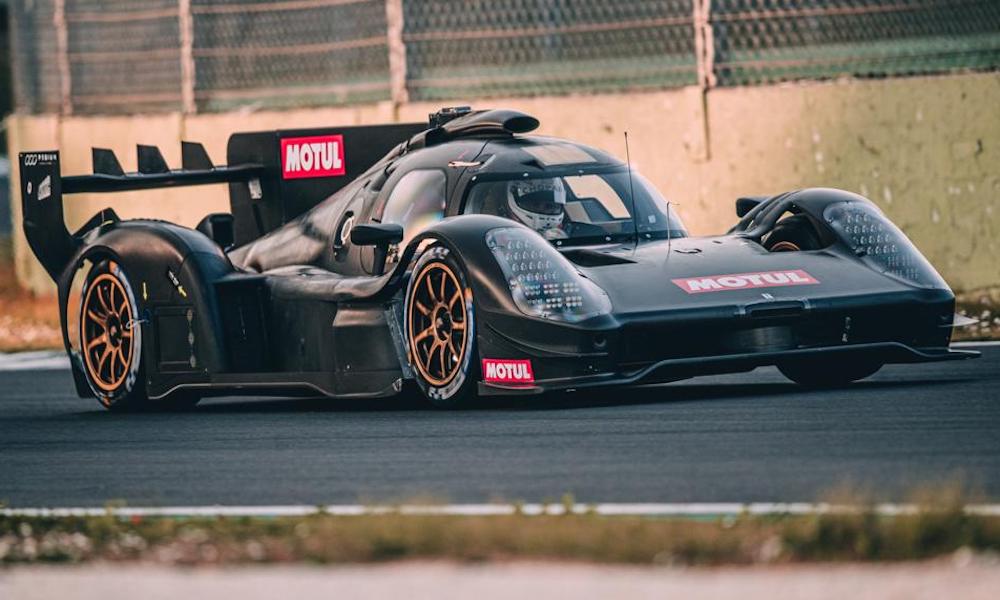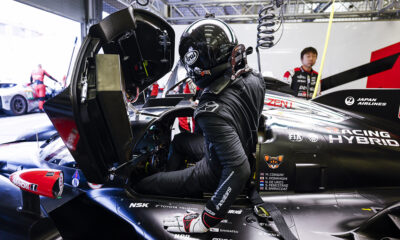
Photo: SCG
Scuderia Cameron Glickenhaus was satisfied with the track debut of its new Le Mans Hypercar which banked a total of 20 laps on its first day of running at Vallelunga, according to team owner Jim Glickenhaus.
2016 FIA World Endurance champion Romain Dumas guided the American automaker’s non-hybrid sports prototype through its first laps on Thursday, kicking off the car’s testing program ahead of its appearance in the WEC Hypercar class.
Speaking at the end of the 007’s first shakedown, Glickenhaus told Sportscar365 that the initial feedback from the Frenchman and the car’s engineering team was positive.
Glickenhaus followed the test remotely from SCG’s headquarters in Danbury, CT., and was fed information throughout the day by the on-site crew from Podium Advanced Technologies which developed and assembled the car at its facility in Italy.
“We have no idea how fast it is or isn’t yet, but we’ll get there,” said Glickenhaus.
“The list of stuff – the knobs should be here, and the seatbelts should be longer or shorter on this side – we’ll get 80 percent of those done tonight. And then we’ll go out tomorrow.
“We’re going to keep going. Franck [Mailleux] will get in the car tomorrow and we think he can run 20 or 30 laps.
“The car sounds incredible – like a P4 Ferrari. It’s a flat-plane crank and it just sounds unbelievable. It sounds like the old days and looks really good. To have built this car from the ground up and to have done this, is like a crazy idea.”
Glickenhaus explained that the rollout presented some mechanical teething issues but the team is expecting to solve these as further mileage is accrued.
The car is currently due to make its race debut at the 8 Hours of Portimao on Apr. 4, racing against Toyota’s new hybrid-powered LMH and an LMP1 car run by Alpine.
“When Romain Dumas gets in the car and his first comment is, ‘congratulations you’ve got a good car’… is it fast? Who knows yet,” said Glickenhaus.
“We need more calibration on the clutch and the engine. It’s a very complicated clutch because you’re not allowed to spin the wheels in the pits. We still have work to do.
“He [Dumas] said the brakes aren’t working right but that’s because the engine isn’t cutting off completely. It’s software. We’ll figure it out.
“The car is pretty. And it’s different, too. I love the rear because nobody has something like that. That is, 50 years from now, what you might see on the lawn at Pebble Beach.”
When asked if he felt the rollout had instilled confidence in the car’s performance, Glickenhaus said: “I do. Because until it rolls out, you don’t know. The rollout can be a disaster and the car can still be OK. But if the rollout is good, the car is going to be good.”
Dumas, who is one of seven drivers named to represent Glickenhaus in the WEC, described his first day behind the wheel of the SCG 007 LMH as “pretty positive”.
“[The] morning was a true shakedown,” tweeted the 24 Hours of Le Mans winner with Audi and Porsche. “We were able to run without problem during the afternoon.
“We have to keep in mind it’s a true new car and new engine for a new prototype class. Always an interesting stage in a project.”
SCG’s second 007 LMH is currently being built-up, with Glickenhaus estimating that the car will be ready to appear during a planned test at Vallelunga on March 15-16.
He added that the first chassis is due to undergo a high-speed test at Monza in early March, where more of the team’s drivers are set to bank their first laps.
SCG “Started from Ground Zero” on Aero Design
The SCG 007 LMH’s track debut gave the first full presentation of the car’s aerodynamic profile, which has taken on many different forms in previously-released render images.
A notable feature is the set of six fins extending from the rear wing. Glickenhaus explained that these are designed to enhance the car’s stability, while the front-end shape was inspired by the Lola T70 sports car that raced in-period in the late 1960s.
“We just started from ground zero,” he said. “The aerodynamics and lift-to-drag ratio is four-to-one. We’ve built cars like our 003C [Nürburgring racer] that are four-to-one.
“Now, how could we change it so that it meets the aerodynamic maximums that you’re allowed, and that it handles well? We pulled the rulebook out and said, how can we get lateral stability – which normally most people do with a shark fin – with low drag?
“The idea was: can we separate the front of the car? Which was really something that Lola did. If you look at our car, the nose is very similar to a Lola T70. They got it right.
“And how do we balance the rear? There was no prohibition about putting these vertical fins that we saw used in fighter aircraft. On fighter aircraft, they are vortex generators.
“But we’re using them as horizontal stability with low drag and the idea that this could give you yaw control with less drag. What we wanted to do was enable the driver to feel when you’re at the limit of the aero.”
Glickenhaus added that SCG has opted for a “Le Mans-type approach” to its sole downforce configuration, which is a stance it shares with Toyota, while he believes that the kit will provide the “best of both worlds” when racing on higher-downforce tracks.

























